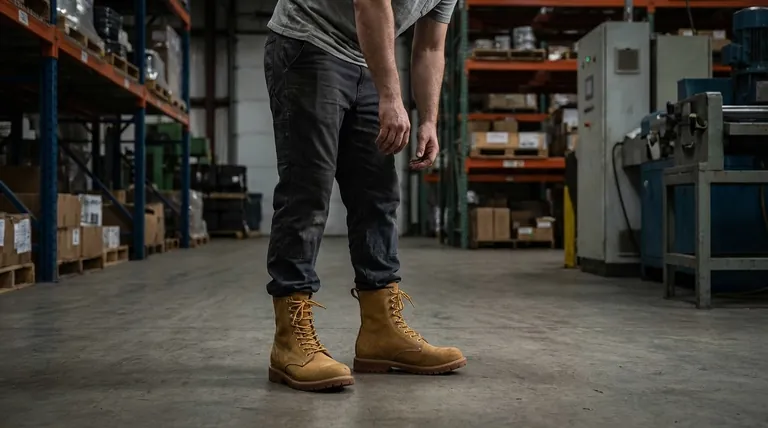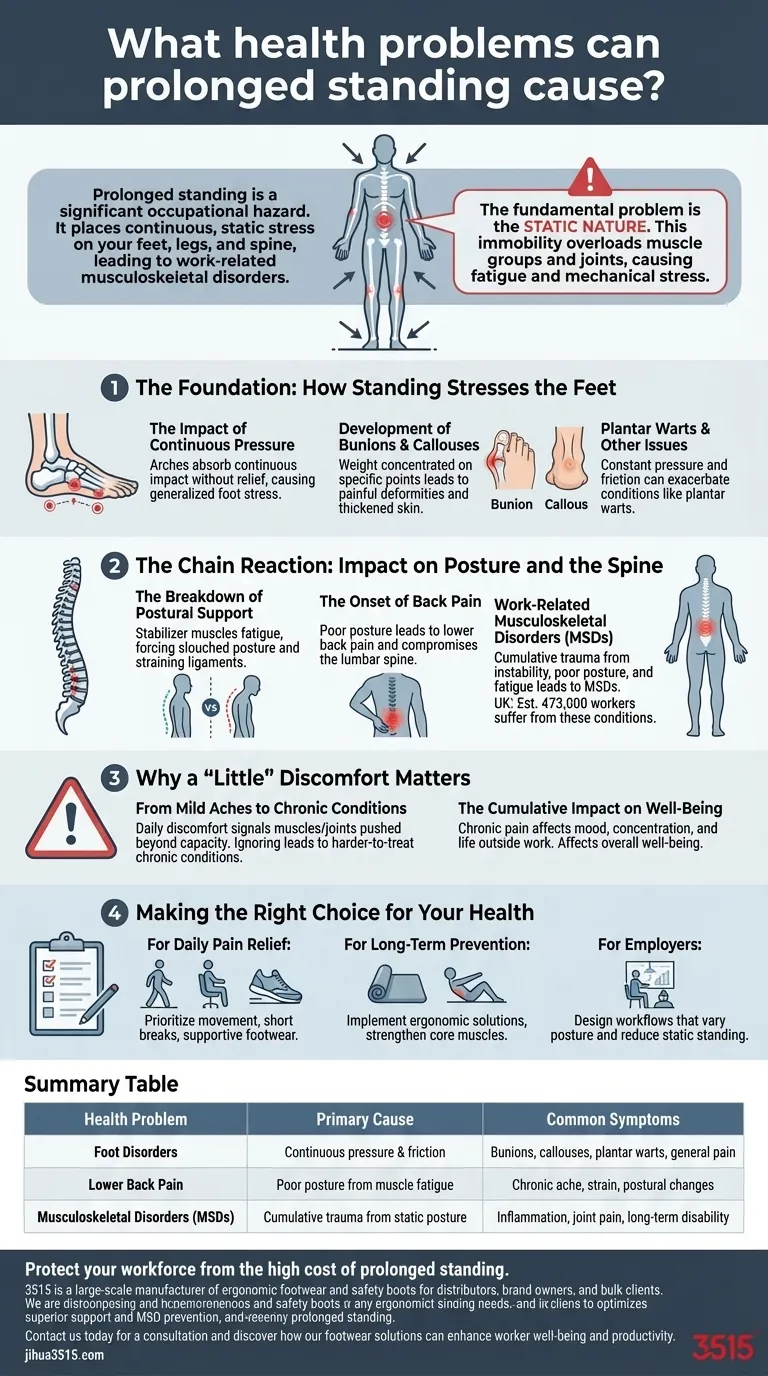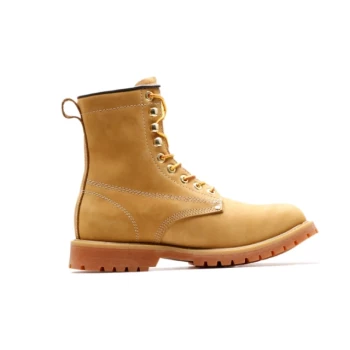Prolonged standing is a significant occupational hazard that directly contributes to a range of health problems, primarily work-related musculoskeletal disorders. It places continuous, static stress on your feet, legs, and spine, leading to issues like chronic back pain, postural changes, and painful foot conditions such as bunions and callouses.
The fundamental problem with prolonged standing is not the posture itself, but its static nature. This immobility overloads specific muscle groups and joints, causing continuous fatigue and mechanical stress that can lead to chronic pain and long-term physical damage.

The Foundation: How Standing Stresses the Feet
Jobs that require standing for hours on end place an immense and unrelenting burden on your feet. This is the starting point for a cascade of health issues that can affect the entire body.
The Impact of Continuous Pressure
Your feet are designed to bear your body's weight, but not without relief. Constant standing forces the arches to absorb continuous impact without the natural reset that comes from walking or sitting.
This unrelenting pressure is the primary driver of generalized foot stress and pain.
Development of Bunions and Callouses
When weight is not distributed properly or is concentrated on specific points for long periods, the body responds defensively.
This can lead to painful deformities like bunions (a bony bump on the joint at the base of the big toe) and the formation of callouses as the skin thickens to protect itself from friction and pressure.
Plantar Warts and Other Issues
The constant pressure and potential for friction in a work shoe also create an environment where other foot problems can arise.
While various factors cause them, conditions like plantar warts can be exacerbated by the persistent stress placed on the soles of the feet.
The Chain Reaction: Impact on Posture and the Spine
The problems that begin in the feet rarely stay there. The strain of prolonged standing travels up the kinetic chain, affecting your posture, back, and overall musculoskeletal system.
The Breakdown of Postural Support
Maintaining a correct standing posture requires active engagement from muscles in your legs, core, and back.
When you stand still for too long, these stabilizer muscles fatigue. This fatigue forces you into a slumped or unnatural posture, straining ligaments and joints that are not meant to carry that load.
The Onset of Back Pain
Poor posture resulting from muscle fatigue is a direct cause of lower back pain. The natural curve of the lumbar spine is compromised, leading to significant strain and, eventually, chronic discomfort.
Work-Related Musculoskeletal Disorders (MSDs)
The combination of foot instability, poor posture, and muscle fatigue contributes to a broad category of injuries known as work-related musculoskeletal disorders (MSDs).
These are not single events but are the result of cumulative trauma over months and years. In the UK alone, an estimated 473,000 workers suffer from these conditions, highlighting the scale of the problem.
Why a 'Little' Discomfort Matters
It is easy to dismiss daily aches and pains as a normal part of a demanding job. However, this is a critical mistake, as minor symptoms are often the first warning signs of developing chronic conditions.
From Mild Aches to Chronic Conditions
The human body is resilient, but it has its limits. Daily discomfort is a signal that your muscles and joints are being pushed beyond their capacity for recovery.
Ignoring these signals allows minor inflammation and strain to evolve into chronic conditions that are much harder to treat and can permanently impact your quality of life.
The Cumulative Impact on Well-Being
Chronic pain is more than just a physical symptom. It affects your mood, your ability to concentrate, and your capacity to enjoy life outside of work.
Treating prolonged standing as a serious occupational hazard is essential for protecting not just your physical health, but your overall well-being.
Making the Right Choice for Your Health
You can take proactive steps to mitigate the risks associated with prolonged standing. The best approach depends on whether you need immediate relief or are focused on preventing long-term harm.
- If your primary focus is alleviating daily pain: Prioritize frequent movement, taking short breaks to sit or walk, and investing in supportive, well-fitting footwear.
- If your primary focus is preventing long-term injury: Implement ergonomic solutions like anti-fatigue mats to reduce stress on your feet and consciously work on strengthening core muscles to improve postural endurance.
- If you are an employer: Recognize your responsibility to engineer a safe work environment by designing workflows that vary employee posture and reduce static standing time.
Ultimately, understanding that static, immobile posture is the true adversary empowers you to protect your body from the cumulative damage of standing work.
Summary Table:
| Health Problem | Primary Cause | Common Symptoms |
|---|---|---|
| Foot Disorders | Continuous pressure & friction | Bunions, callouses, plantar warts, general pain |
| Lower Back Pain | Poor posture from muscle fatigue | Chronic ache, strain, postural changes |
| Musculoskeletal Disorders (MSDs) | Cumulative trauma from static posture | Inflammation, joint pain, long-term disability |
Protect your workforce from the high cost of prolonged standing. As a large-scale manufacturer, 3515 produces a comprehensive range of ergonomic footwear and safety boots designed to provide superior support, reduce fatigue, and prevent the musculoskeletal disorders detailed in this article. Whether you are a distributor, brand owner, or a bulk client requiring specialized footwear for demanding environments, our production capabilities encompass all types of shoes and boots built for health and durability.
Contact us today for a consultation and discover how our footwear solutions can enhance worker well-being and productivity.
Visual Guide

Related Products
- Durable Goodyear Welt Leather Work Boots for Wholesale & Private Label
- Wholesale Durable 6-Inch Work Boots | Custom & Private Label Manufacturer
- Durable Leather Work Boots Wholesale Manufacturer & Custom Factory
- Wholesale Comfortable Business Casual Shoes Custom Manufacturing
- Durable Leather Work Boots for Wholesale & Custom OEM Manufacturing
People Also Ask
- What does ASTM F2413-18 standard cover? Your Guide to U.S. Safety Toe Footwear Ratings
- What is the significance of impact resistance (IR) in safety boots? Protect Your Feet from Severe Injuries
- Which material is the most durable for work boots? Find the Right Boot for Your Job
- What cultural and environmental considerations are tied to wearing shoes indoors? Balance Hygiene, Tradition, and Foot Health
- Why is the last important in work boot design? It's the Anatomical Blueprint for Comfort & Safety


















